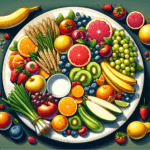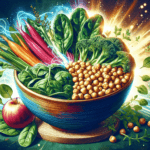So, you’ve been fasting for a while and now it’s finally time to break that extended fast. Whether it’s for health reasons or to reset your body, knowing what foods to reintroduce into your diet is key. In this article, we’ll explore the best foods to break an extended fast with, focusing on nourishing options that won’t shock your system or leave you feeling bloated. From easily digestible fruits to nutrient-dense vegetables and protein-packed sources, we’ve got you covered in making a smooth transition back to eating without any unpleasant surprises.
Introduction
When it comes to breaking an extended fast, what you put into your body is just as important as the fast itself. It’s crucial to reintroduce food gradually, consider the macronutrient composition, and listen to your body’s needs. Hydration is another key factor, as is choosing the best foods to break your extended fast with. In this article, we will explore all of these considerations in detail to help you navigate the process of breaking an extended fast and ensure a smooth transition back to regular eating.
Why Breaking an Extended Fast is Important
Breaking an extended fast properly is essential for several reasons. Firstly, it allows your digestive system to gradually adjust to the reintroduction of food, minimizing the risk of discomfort or digestive upset. Additionally, breaking a fast correctly also helps prevent blood sugar spikes and crashes, as well as nutrient imbalances. By taking the time to break your fast mindfully, you can ensure that your body is able to process and utilize the nutrients from the food you consume more effectively.
Considerations Before Breaking an Extended Fast
Consulting a Healthcare Professional
Before breaking an extended fast, it is always wise to consult with a healthcare professional, especially if you have any underlying health conditions or concerns. They can provide personalized guidance and ensure that the process aligns with your specific needs. A healthcare professional can also help address any potential nutrient deficiencies that may have occurred during the fast and recommend appropriate supplements or dietary modifications.
Reintroducing Food Gradually
One of the most important considerations when breaking an extended fast is to reintroduce food gradually. After a period of fasting, your digestive system may have become less active, and suddenly overwhelming it with a large meal can lead to discomfort or digestive distress. Begin by consuming small portions of easily digestible foods and gradually increase the quantity and complexity of your meals over a few days. This allows your digestive system to adapt slowly and minimizes the risk of digestive issues.
Listening to Your Body
During the process of breaking an extended fast, it’s crucial to listen to your body’s cues and respond accordingly. Pay attention to any signs of discomfort or digestive distress and adjust your food choices and portion sizes accordingly. Everyone’s body is unique, and what works for one person may not work for another. Trust your body’s wisdom and make choices that align with how you feel.
The Ideal Macronutrient Composition
Balancing Protein, Fat, and Carbohydrates
Achieving a balanced macronutrient composition is important when breaking an extended fast. Ideally, your meals should contain a balance of protein, fat, and carbohydrates to provide your body with the necessary nutrients and energy it needs. Strive for a balanced plate that includes lean protein sources, healthy fats, and complex carbohydrates.
Choosing High-Quality Protein
Protein is an essential component of any meal, and it becomes especially important when breaking an extended fast. Opt for high-quality protein sources such as grilled chicken breast, salmon, tofu, or tempeh. These foods are rich in essential amino acids and provide the building blocks needed for cellular repair and muscle recovery.
Healthy Fats for Satiety
Incorporating healthy fats into your meals can help promote satiety and provide a source of sustained energy. Avocado, olive oil, nuts, and seeds are all excellent choices. These fats not only provide essential nutrients but also aid in the absorption of fat-soluble vitamins. Be mindful of portion sizes, as fats are more calorie-dense than proteins and carbohydrates.
Incorporating Complex Carbohydrates
Complex carbohydrates are an important part of a well-balanced meal, providing a steady source of energy. Opt for foods like sweet potatoes, quinoa, brown rice, or whole grains. These foods are rich in fiber, vitamins, and minerals that support overall health and digestion.
Hydrating with Water and Electrolytes
Benefits of Hydration
Proper hydration is crucial when breaking an extended fast. Water plays a vital role in digestion, nutrient absorption, and overall bodily functions. It helps flush out toxins, supports optimal kidney function, and aids in the regulation of body temperature. Adequate hydration is essential for maintaining energy levels and overall well-being.
Adding Electrolytes to Water
Electrolytes are minerals that help maintain fluid balance and support proper muscle and nerve function. When breaking an extended fast, it can be beneficial to add electrolytes to your water to replenish any lost during the fast and support hydration. You can find electrolyte powders or tablets in health food stores or make your own with a pinch of sea salt and a squeeze of lemon or lime.
Best Foods for Breaking an Extended Fast
Now that we have covered the considerations and macronutrient composition for breaking an extended fast, let’s explore some of the best foods to break your fast with.
Nourishing Broth or Soup
Benefits of Nourishing Broth or Soup
A warm and nourishing bowl of broth or soup can be an excellent choice when breaking an extended fast. Broth is rich in vitamins, minerals, and amino acids that support gut health and aid in digestion. It provides hydration and soothes the digestive system after a period of fasting. Opt for homemade bone broth or vegetable broth for the most nutrient-dense option.
Varieties to Try
When choosing a nourishing broth or soup, consider options like chicken bone broth, vegetable soup, miso soup, or ginger and turmeric broth. These options provide a comforting and nutrient-rich start to your refeeding process.
Soft and Easily Digestible Foods
Mashed Avocado
Avocado is not only delicious but also a great choice for breaking an extended fast. It is rich in healthy fats, fiber, and essential nutrients. Mashed avocado can be spread on toast or enjoyed as a dip with vegetable sticks. Its creamy texture and gentle taste make it a gentle option for reintroducing solid foods.
Scrambled Eggs
Scrambled eggs are another excellent choice for breaking an extended fast. They are easy to digest and provide a good source of protein. Opt for organic or pasture-raised eggs for the highest nutrient content. You can add vegetables or herbs for added flavor and nutrition.
Baked Sweet Potato
Baked sweet potatoes are a nutrient-dense option that provides complex carbohydrates, fiber, and vitamins. The soft texture and natural sweetness make them a satisfying choice for breaking an extended fast. Top with a drizzle of olive oil and a sprinkle of sea salt for added flavor.
Protein-Rich Foods
Grilled Chicken Breast
Grilled chicken breast is a lean protein source that can help replenish your body’s nutrient stores after an extended fast. It is low in fat and high in essential amino acids, making it an ideal choice for muscle recovery and repair.
Salmon or Tuna
Salmon or tuna are excellent sources of omega-3 fatty acids, high-quality protein, and essential nutrients. These fatty fish options provide a dose of healthy fats and support brain health, heart health, and overall well-being.
Tofu or Tempeh
For those following a plant-based diet, tofu or tempeh can be a great option for breaking an extended fast. These soy-based products are high in protein and provide essential amino acids. They are versatile and can be added to stir-fries, salads, or wraps for a satisfying meal.
Conclusion
Breaking an extended fast requires careful consideration and a mindful approach to ensure a smooth transition back to regular eating. Consulting a healthcare professional, reintroducing food gradually, and listening to your body are crucial steps in the process. Pay attention to the macronutrient composition, hydration with water and electrolytes, and choose the best foods for breaking your fast. By following these guidelines, you can nourish your body and support its recovery after an extended period of fasting. Remember to prioritize your health and well-being as you break your fast and continue your wellness journey.




